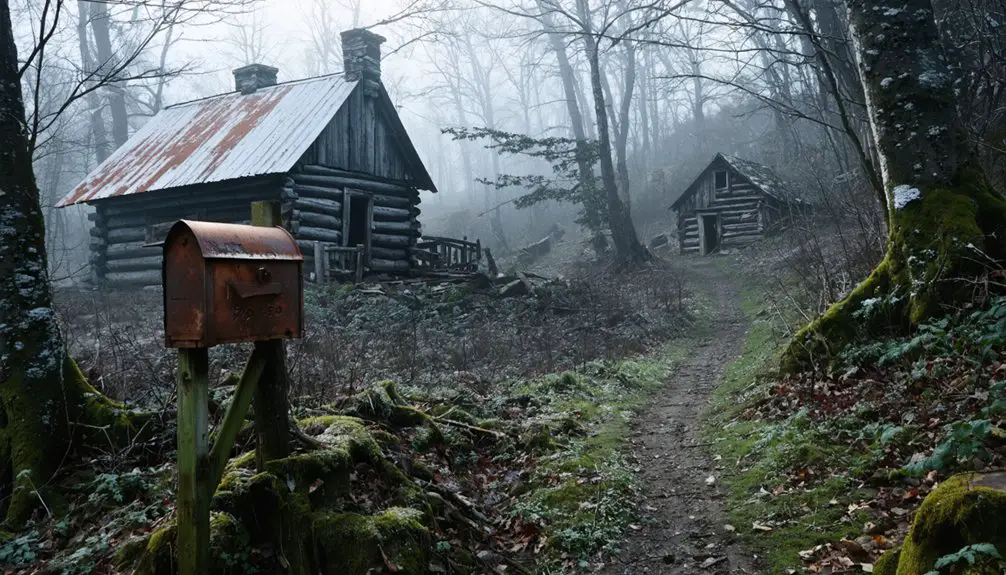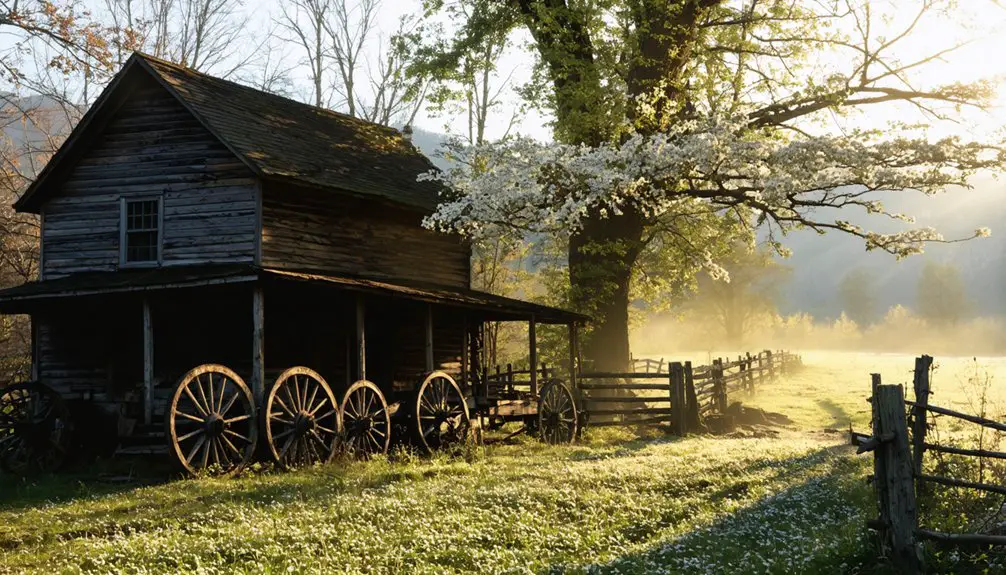You’ll find Fork Mountain’s abandoned coal mining ruins in Tennessee’s Cumberland Mountains, where a bustling company town operated from the early 1900s through mid-century. The site once produced 1,000 tons of coal daily through six underground mines, supporting thousands of workers and their families with company housing, stores, and schools. Today, crumbling foundations, rusted equipment, and stone chimneys dot the overgrown landscape, offering glimpses into Tennessee’s rich mining heritage.
Key Takeaways
- Fork Mountain flourished as a coal mining community in the early 1900s, producing over 84,000 tons annually through six underground mines.
- The town operated as a company-controlled settlement with company housing, stores, schools, and a scrip-based economic system.
- Daily life centered around three mining shifts, with the community sharing strong social bonds through work, church, and local gatherings.
- Decline began mid-20th century when mining operations dwindled, causing mass exodus and abandonment of local businesses and services.
- Today, the site features mining ruins, crumbling foundations, and abandoned structures, accessible via steep gravel roads requiring off-road vehicles.
The Rise of a Coal Mining Community
While coal mining in the surrounding region had existed since the mid-19th century, Fork Mountain‘s rise as a prominent mining community began in the early 1900s.
You’ll find that drift mines dominated the landscape, with miners following coal seams horizontally into the mountainside at relatively flat angles. Daily passenger trains connected Fork Mountain to other communities via rail service.
The Wilder Seam, lying about 180 feet beneath the plateau surface, proved particularly valuable. Historical records show coal production skyrocketed from 680 tons in 1901 to over 84,000 tons just two years later.
Life in the Company Town
As mining operations expanded in Fork Mountain, daily life centered around the company store, which served as the town’s commercial and social hub.
Similar to the infamous Glenmary Coal & Coke operation that ran from 1885-1904, you’d find everything from groceries and tools to the post office under one roof, but you’d have to use company scrip to make your purchases. The mining company controlled both prices and product availability, ensuring your continued company loyalty.
You’d live in company-provided housing, typically modest and uniform, clustered near the mines for easy access to work shifts. Due to the presence of multiple geographical locations sharing the Fork Mountain name, mapmakers had to specify this particular mining settlement.
Your children would attend the company school, and you’d worship at the local church, all within walking distance. The paternalistic system kept you economically tied to the company through housing, store credit, and employment, while railroads connected your isolated community to the outside world.
Mining Operations and Economic Impact
You’ll find Fork Mountain’s six underground coal mines were accessed through both drift tunnels and vertical shafts, with miners descending daily into the Bon Air and Brushy Mountain coal seams via elevator cages and horizontal passageways.
The mines required extensive support infrastructure, including ventilation systems, rail sidings, and storage facilities, while employing a significant portion of the local workforce throughout the early to mid-1900s. The facility’s operations were impressive, producing 1,000 tons of coal per day by 1896.
These operations formed the economic backbone of Fork Mountain, supporting thousands of residents across Morgan and Anderson counties until the industry’s decline led to the town’s abandonment by 1980.
Mine Development and Growth
During the early to mid-20th century, Fork Mountain emerged as a significant coal mining center, hosting at least six underground mines by the 1950s.
You’d find both drift mines with horizontal tunnels following coal seams and shaft mines requiring 10-foot-square vertical passages to reach deeper deposits.
Mine ownership in the area reflected the dynamic nature of the industry. Companies like Bon Air Coal controlled vast tracts – over 50,000 acres at their peak. The Barbour Coal & Coke company expanded operations by opening three new mines and building camps for their workers in 1916.
Corporate shifts were common, as seen when Fodder Stack and Coal Company acquired Petros Coal Mining Company’s assets in 1916.
The mines’ development spurred vital infrastructure growth, including a railroad siding for coal transport and a school serving the mining community, making Fork Mountain a thriving hub of regional commerce and employment.
Workers and Daily Operations
The underground operations at Fork Mountain mines demanded a diverse workforce to function effectively. You’d find skilled operators manning the cages that transported miners vertically through 10-foot-square shafts, while supervisors coordinated shift changes and monitored worker safety.
Surface crews maintained equipment and managed the essential rail infrastructure that connected Fork Mountain’s at least six mines to broader markets.
- Underground miners endured long shifts in hazardous conditions, battling poor air quality and risk of explosions.
- Ventilation systems required constant monitoring to prevent dangerous gas buildup.
- Support roles included maintenance crews, transportation personnel, and safety officers.
- The mining camp’s economic vitality depended on the punctual coordination of daily operations, from coal extraction to rail shipment.
Economic Ripple Through Community
As Fork Mountain’s six underground coal mines reached peak operations in the mid-20th century, they catalyzed a robust economic ecosystem that stretched far beyond the mine shafts themselves.
You’d have seen bustling commerce spring up around the mining operations, with railroads and local businesses thriving from the steady flow of workers and coal shipments.
The community’s economic fluctuations mirrored the mines’ fortunes, particularly during Tennessee’s coal industry peaks and the devastating 1922 crash.
Despite the precarious nature of mining work, community resilience showed through the establishment of schools, postal services, and housing developments.
Yet when the mines began closing, Fork Mountain couldn’t sustain its economic significance.
Daily Routines of Fork Mountain Families

Life in Fork Mountain revolved around three distinct shifts at the underground coal mines, structuring daily routines for nearly every family in this close-knit community. Like the residents of Little River Lumber Company, families adapted their schedules around industrial work that shaped their mountain community. Similar to families at Elkmont Ghost Town, mining families maintained vacation cabins as weekend retreats.
The steady rhythm of coal mine shifts shaped Fork Mountain’s daily life, binding families together in an unbreakable chain of shared purpose.
You’d find family chores seamlessly woven into the mining schedule, with meals and household tasks coordinated around shift changes. Children attended school during weekdays while also helping with domestic duties, and families gathered at community gatherings to strengthen their bonds.
- Wood-burning stoves needed constant attention for cooking and heating, requiring daily firewood collection.
- Women tackled intensive household tasks like hand-washing laundry and preserving food for winter.
- Water collection became a regular group activity, often involving multiple family members.
- Post-shift socializing brought neighbors together to share news and support one another through mining’s challenges.
Architecture and Infrastructure
Three distinct architectural styles characterized Fork Mountain’s built environment during its heyday: balloon-frame cottages with board and batten exteriors, historic log cabins like the Levi Trentham and Smith properties, and larger lodges found along Millionaires’ Row.
You’ll find cottage architecture from 1910-1930 showcasing the area’s popularity among wealthy families seeking summer retreats.
The infrastructure evolution included early logging roads that served as primary access routes, though many fell into disuse after the town’s abandonment. While most structures began as rustic dwellings without modern utilities, they relied on wood-burning stoves and nearby springs for basic needs. Similar to early logging communities in Elkmont, these roads were essential for transporting timber and supplies. To avoid confusion with other locations, the town was often referred to as Fork Mountain Settlement.
The 1934 Appalachian Clubhouse exemplified the community’s investment in social spaces, though many buildings have since deteriorated, leaving only interpretive kiosks to mark their locations.
Social Fabric and Community Bonds
While the mines physically anchored Fork Mountain’s economy, they also forged the town’s social identity between 1920 and 1980.
You’ll find that community resilience emerged from shared underground labor and mutual dependence in this isolated Appalachian setting. The town’s cultural identity centered around key gathering places that strengthened social bonds.
- The Devonia post office served as a crucial communication hub, connecting residents to the outside world.
- A local schoolhouse doubled as both an educational facility and community meeting space.
- Mining families developed unique cultural practices, including storytelling and folklore specific to their experiences.
- Economic interdependence created strong social ties, as families relied on each other through mining’s risks and rewards.
These social connections endured until the mines’ closure triggered the community’s eventual dissolution.
The Decline Years
As coal mining operations dwindled in Fork Mountain during the mid-20th century, the town’s fate became increasingly dire.
You’d have witnessed the decline dynamics unfold as mines closed one by one, leaving scores of workers jobless and desperate for alternatives. The domino effect was ruthless – as families departed, local businesses couldn’t survive, and essential services vanished.
Population shifts hit hard as younger residents fled to urban areas, leaving behind an aging community.
You’d have seen schools shuttering, the post office closing, and medical facilities disappearing. Without tax revenue, roads crumbled and utilities failed. The town’s single-industry dependency proved fatal, as no new businesses stepped in to fill the void.
Nature began reclaiming abandoned structures while mining pollution scarred the landscape, transforming Fork Mountain into a shell of its former self.
Remnants and Ruins Today
Today’s Fork Mountain stands as a haunting collection of mining ruins, where you’ll find fragmented building foundations and rusted equipment scattered across the Tennessee landscape.
Unlike the preserved structures of nearby Elkmont, Fork Mountain’s abandoned structures remain untamed and authentic, with nature slowly reclaiming these historical artifacts. The site offers a raw, unfiltered glimpse into Tennessee’s mining past, though you’ll need to exercise caution when exploring the unstable terrain.
Where untamed ruins tell tales of Tennessee’s mining heritage, nature slowly embraces the authentic remains of a forgotten mountain community.
- Stone chimneys and crumbling wall fragments mark the locations of former worker homesteads
- Deteriorating cabin remains lie scattered throughout the mountainside
- Rusted mining equipment and tools rest among overgrown vegetation
- Interpretive markers along hiking trails identify specific ruins and mining relics
Historical Significance in Tennessee Mining
During its operational peak in the early-to-mid 20th century, Fork Mountain emerged as an essential hub in Tennessee’s coal mining industry, hosting six underground mines that exemplified the region’s extraction practices.
You’ll find that mining techniques at Fork Mountain included both drift and shaft mining, with workers descending into deep veins via elevator cages.
The town played a significant role in Tennessee’s “black gold” production, contributing to the Cumberland Plateau’s reputation as an important coal-producing region.
Like many Appalachian mining communities, Fork Mountain witnessed its share of labor disputes and dangerous working conditions. The nearby Brushy Mountain prison’s use of convict labor reflected the complex labor practices that shaped Tennessee’s mining history.
The town’s eventual decline mirrored broader changes in the state’s coal industry by mid-century.
Preservation Challenges and Future Prospects
If you’re planning to explore Fork Mountain’s ruins today, you’ll face significant access challenges due to overgrown trails and deteriorating infrastructure that the National Park Service hasn’t yet addressed.
While historical documentation of the site exists through the National Register of Historic Places, many of Fork Mountain’s specific building records and photographs remain scattered or lost.
The site’s future could benefit from community-driven preservation initiatives, similar to the Friends of the Smokies’ efforts at Elkmont, though such projects would require substantial funding and administrative coordination.
Physical Site Access Issues
While Fork Mountain’s historical significance remains compelling, severe access limitations pose significant challenges for preservation efforts.
You’ll find the primary route involves a steep gravel haulroad from Moores Camp, climbing 1,300 feet over just two miles. The terrain difficulties create substantial access challenges for standard vehicles and maintenance crews alike.
- The unpaved roads require high-clearance or off-road vehicles, particularly during wet seasons when conditions deteriorate.
- You’ll encounter multiple gravel paths branching toward old mining sites, though many lack proper marking or maintenance.
- Limited infrastructure means no reliable cellular coverage, restrooms, or emergency services.
- The intersection of public routes with private and reclaimed mining lands requires special permits and creates restricted entry zones.
Documentation and Historical Records
Beyond the physical challenges of accessing Fork Mountain, the preservation of its historical record faces equally intimidating obstacles.
You’ll find archival challenges throughout the limited documentation that remains, with many primary records lost or scattered since the town’s abandonment. While mining company documents, census data, and historical maps provide some insights, significant documentation gaps exist in telling Fork Mountain’s complete story.
The preservation efforts face ongoing hurdles, from deteriorating paper records to limited funding for proper archival storage.
You can discover fragments of the town’s history through oral histories from former residents and their descendants, though these accounts remain largely uncollected.
Digital initiatives offer new hope, as historical societies work to preserve what remains through modern technology, but time continues to threaten the survival of Fork Mountain’s historical record.
Community Restoration Opportunities
Despite the intimidating preservation challenges at Fork Mountain, several opportunities exist for community-based restoration initiatives.
You’ll find that successful preservation efforts require a balanced approach between professional expertise and local involvement. While funding limitations and regulatory barriers pose significant hurdles, community restoration initiatives can help bridge these gaps through strategic partnerships and volunteer engagement.
- You can participate in organized heritage tourism programs that generate funds for preservation while sharing authentic local history.
- Your involvement in educational workshops teaches traditional restoration techniques while preserving historic structures.
- You’re able to join volunteer teams that assist with vegetation control and basic maintenance tasks.
- Your support of public awareness campaigns helps secure grants and encourages broader community involvement.
Frequently Asked Questions
Are There Any Haunted Locations or Ghost Stories Associated With Fork Mountain?
You’ll find few documented ghost sightings at this location, though nearby haunted tales from abandoned mines and the surrounding Smoky Mountains region suggest similar supernatural activity could exist here.
What Were the Most Common Causes of Mining Accidents in Fork Mountain?
Like canaries warning miners of danger, you’d find methane explosions, poisonous gas leaks, structural collapses, and mechanical failures – all made worse by poor mining safety and insufficient accident prevention measures underground.
How Did Native American Communities Interact With the Mining Settlement?
You’ll find Native Americans had limited trade relations with mining settlers, though some shared knowledge of mineral deposits. Cultural exchange was minimal, as most indigenous peoples were displaced before extensive mining began.
What Wildlife Has Reclaimed the Abandoned Town Site Today?
You’ll spot white-tailed deer 3x more frequently than in inhabited areas. The abandoned town’s structures now host diverse wildlife, from growing deer populations to native bird species reclaiming their ancestral territories.
Did Any Famous People or Notable Historical Figures Visit Fork Mountain?
You won’t find any documented famous visitors or major historical events here – except for Ohio State Senator Bill Harris, who was born in the area before becoming its most notable figure.
References
- https://smokymountainnationalpark.com/blog/smoky-mountain-ghost-stories/
- https://www.tnvacation.com/articles/ghost-towns-tennessee
- https://www.tnmagazine.org/19-ghost-towns-in-tennessee-that-are-not-underwater/
- https://tngenweb.org/cannon/ghost-towns/
- https://www.appalachianhistory.net/2014/07/ghost-towns-cumberland-plateau.html
- http://tncoal.com/articlesAndExcerpts.php
- https://www.miningonthemountain.org/caney-fork-article
- https://coalcampusa.com/tennessee-coal-mines/tennessee-coal-mines.htm
- https://en.wikipedia.org/wiki/Fork_Mountain
- https://www.secrethike.com/post/a-ghostly-train-and-defunct-coal-mine



